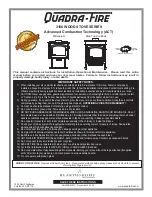
10
7061-196J
April 24, 2019
Explorer II
User Guide
2
Operating Instructions
A. Over-Firing Your Appliance
Visit
www.quadrafire.com/shopping-tools/videos
to view
product and use & care videos.
1. Symptoms of Over-Firing
Symptoms of over-firing may include one or more of
the following:
•
Chimney connector or appliance glowing
•
Roaring, rumbling noises
•
Loud cracking or banging sounds
•
Metal warping
•
Chimney fire
2. What To Do if Your Appliance is Over-Firing
•
Immediately close the door and air controls to reduce
air supply to the fire.
•
If you suspect a chimney fire, call the fire department
and evacuate your house.
•
Contact your local chimney professional and have
your appliance and appliance pipe inspected for any
damage.
•
Do not use your appliance until the chimney
professional informs you it is safe to do so.
B. Wood Selection & Storage
Burn only dry seasoned wood. Store wood under cover,
out of the rain and snow. Dry and well-seasoned wood will
not only minimize the chance of creosote formation, but will
give you the most efficient fire. Even dry wood contains at
least 15% moisture by weight, and should be burned hot
enough to keep the chimney hot for as long as it takes to
dry the wood out - about one hour. It is a waste of energy to
burn unseasoned wood of any kind.
Dead wood lying on the forest floor should be considered
wet, and requires full seasoning time. Standing dead wood
can be considered to be about 2/3 seasoned. To tell if
wood is dry enough to burn, check the ends of the logs. If
there are cracks radiating in all directions from the center,
it is dry. If your wood sizzles in the fire, even though the
surface is dry, it may not be fully cured.
Splitting wood before it is stored reduces drying time.
Wood should be stacked so that both ends of each piece
are exposed to air, since more drying occurs through the
cut ends than the sides. This is true even with wood that
has been split. Store wood under cover, such as in a shed,
or covered with a tarp, plastic, tar paper, sheets of scrap
plywood, etc., as uncovered wood can absorb water from
rain or snow, delaying the seasoning process.
C. Burning Process
In recent years there has been an increasing concern
about air quality. Much of the blame for poor air quality
has been placed on the burning of wood for home heating.
In order to improve the situation, we at Quadra-Fire
have developed cleaner-burning wood appliances that
surpass the requirements for emissions established by our
governing agencies. These wood appliances, like any other
appliances, must be properly operated in order to insure
that they perform the way they are designed to perform.
Improper operation can turn most any wood appliance into
a smoldering environmental hazard.
1. Kindling or First Stage
It helps to know a little about the actual process of burning
in order to understand what goes on inside a appliance.
The first stage of burning is called the kindling stage. In this
stage, the wood is heated to a temperature high enough
to evaporate the moisture which is present in all wood.
The wood will reach the boiling point of water (212°F) and
will not get any hotter until the water is evaporated. This
process takes heat from the coals and tends to cool the
appliance.
Fire requires three things to burn - fuel, air and heat. So, if
heat is robbed from the appliance during the drying stage,
the new load of wood has reduced the chances for a good
clean burn. For this reason, it is always best to burn dry,
seasoned firewood. When the wood isn’t dry, you must
open the air controls and burn at a high burn setting for a
longer time to start it burning. The heat generated from the
fire should be warming your home and establishing the flue
draft, not evaporating the moisture out of wet, unseasoned
wood, resulting in wasted heat.
Fire Risk. Do not over-fire.
Over-firing may ignite creosote or will damage
the appliance and chimney.
WARNING
To prevent over-firing your appliance, DO NOT:
•
Use flammable liquids
• Overload with wood
•
Burn trash or large amounts of scrap lumber
•
Permit too much air to the fire
Hearth & Home Technologies WILL NOT warranty
appliances that exhibit evidence of over-firing. Evidence
of over-firing includes, but is not limited to:
•
Warped air tube
•
Deteriorated refractory brick retainers
•
Deteriorated baffle and other interior components











































